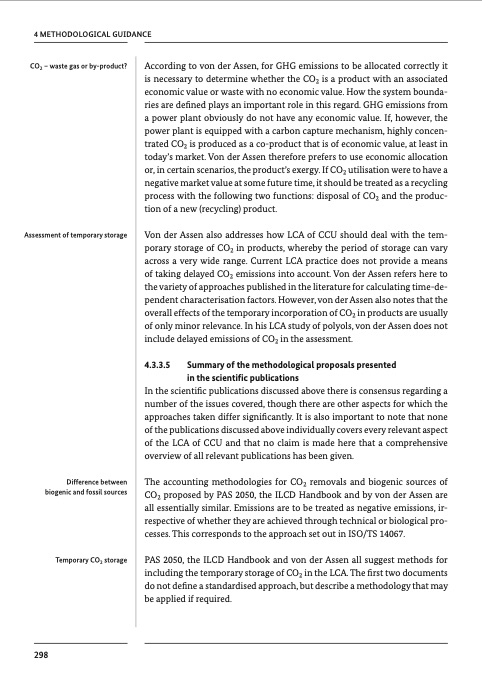
PDF Publication Title:
Text from PDF Page: 301
4 METHODOLOGICAL GUIDANCE CO2 – waste gas or by-product? According to von der Assen, for GHG emissions to be allocated correctly it is necessary to determine whether the CO2 is a product with an associated economic value or waste with no economic value. How the system bounda- ries are defined plays an important role in this regard. GHG emissions from a power plant obviously do not have any economic value. If, however, the power plant is equipped with a carbon capture mechanism, highly concen- trated CO2 is produced as a co-product that is of economic value, at least in today’s market. Von der Assen therefore prefers to use economic allocation or, in certain scenarios, the product’s exergy. If CO2 utilisation were to have a negative market value at some future time, it should be treated as a recycling process with the following two functions: disposal of CO2 and the produc- tion of a new (recycling) product. Von der Assen also addresses how LCA of CCU should deal with the tem- porary storage of CO2 in products, whereby the period of storage can vary across a very wide range. Current LCA practice does not provide a means of taking delayed CO2 emissions into account. Von der Assen refers here to the variety of approaches published in the literature for calculating time-de- pendent characterisation factors. However, von der Assen also notes that the overall effects of the temporary incorporation of CO2 in products are usually of only minor relevance. In his LCA study of polyols, von der Assen does not include delayed emissions of CO2 in the assessment. 4.3.3.5 Summary of the methodological proposals presented in the scientific publications In the scientific publications discussed above there is consensus regarding a number of the issues covered, though there are other aspects for which the approaches taken differ significantly. It is also important to note that none of the publications discussed above individually covers every relevant aspect of the LCA of CCU and that no claim is made here that a comprehensive overview of all relevant publications has been given. The accounting methodologies for CO2 removals and biogenic sources of CO2 proposed by PAS 2050, the ILCD Handbook and by von der Assen are all essentially similar. Emissions are to be treated as negative emissions, ir- respective of whether they are achieved through technical or biological pro- cesses. This corresponds to the approach set out in ISO/TS 14067. PAS 2050, the ILCD Handbook and von der Assen all suggest methods for including the temporary storage of CO2 in the LCA. The first two documents do not define a standardised approach, but describe a methodology that may be applied if required. Assessment of temporary storage Difference between biogenic and fossil sources Temporary CO2 storage 298PDF Image | Chemical Processes and Use of CO2

PDF Search Title:
Chemical Processes and Use of CO2Original File Name Searched:
CO2_Buch_engl.pdfDIY PDF Search: Google It | Yahoo | Bing
NFT (Non Fungible Token): Buy our tech, design, development or system NFT and become part of our tech NFT network... More Info
IT XR Project Redstone NFT Available for Sale: NFT for high tech turbine design with one part 3D printed counter-rotating energy turbine. Be part of the future with this NFT. Can be bought and sold but only one design NFT exists. Royalties go to the developer (Infinity) to keep enhancing design and applications... More Info
Infinity Turbine IT XR Project Redstone Design: NFT for sale... NFT for high tech turbine design with one part 3D printed counter-rotating energy turbine. Includes all rights to this turbine design, including license for Fluid Handling Block I and II for the turbine assembly and housing. The NFT includes the blueprints (cad/cam), revenue streams, and all future development of the IT XR Project Redstone... More Info
Infinity Turbine ROT Radial Outflow Turbine 24 Design and Worldwide Rights: NFT for sale... NFT for the ROT 24 energy turbine. Be part of the future with this NFT. This design can be bought and sold but only one design NFT exists. You may manufacture the unit, or get the revenues from its sale from Infinity Turbine. Royalties go to the developer (Infinity) to keep enhancing design and applications... More Info
Infinity Supercritical CO2 10 Liter Extractor Design and Worldwide Rights: The Infinity Supercritical 10L CO2 extractor is for botanical oil extraction, which is rich in terpenes and can produce shelf ready full spectrum oil. With over 5 years of development, this industry leader mature extractor machine has been sold since 2015 and is part of many profitable businesses. The process can also be used for electrowinning, e-waste recycling, and lithium battery recycling, gold mining electronic wastes, precious metals. CO2 can also be used in a reverse fuel cell with nafion to make a gas-to-liquids fuel, such as methanol, ethanol and butanol or ethylene. Supercritical CO2 has also been used for treating nafion to make it more effective catalyst. This NFT is for the purchase of worldwide rights which includes the design. More Info
NFT (Non Fungible Token): Buy our tech, design, development or system NFT and become part of our tech NFT network... More Info
Infinity Turbine Products: Special for this month, any plans are $10,000 for complete Cad/Cam blueprints. License is for one build. Try before you buy a production license. May pay by Bitcoin or other Crypto. Products Page... More Info
| CONTACT TEL: 608-238-6001 Email: greg@infinityturbine.com | RSS | AMP |